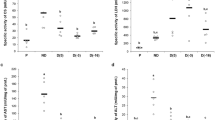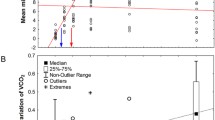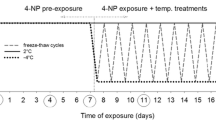Abstract
Exposure of the silkworm(Philosamia ricini) larvae to cold temperature (2‡C) and subsequent exposure to room temperature (29‡ C) resulted in the mortality of the larvae.
Cold exposure brought about significant decrease in enzymic activity of proteases, aminotransferases, diacylglycerol lipase and in the amounts of some haemolymph sugars and polyols. However, glycerol increased sharply in response to severe cold exposure. There was also a marked increase in the levels of protein, pyruvate, total free amino acids, total lipid, phospholipid and triacylglycerols.
In the colder environment, carbohydrates served as the energy source. Glycerol appears to have conferred cryoprotection to the cold-stressedPhilosamia ricini larvae.
Similar content being viewed by others
References
Anderson, M. and McCarty, R. E. (1972)Anal. Biochem.,45, 260.
Anderson, R. L. and Mutchmor, J. A. (1971)J. Insect Physiol.,17, 2205.
Baldwin, J. and Hochachka, P. W. (1970)Biochem. J.,116, 883.
Baust, J. C. (1973)Cryobiology,10, 197.
Cherry, I. S. and Crandall, Jr. L. A. (1931)Am. J. Physiol.,100, 266.
Cymborowski, B. and Bogus, M. J. (1976)J. Insect Physiol.,22, 669.
Davidson, T. F. (1969)J. Insect Physiol.,15, 977.
Deykin, D. and Goodman, D. S. (1962)J. Biol Chem.,237, 3649.
Elson, L. A. and Morgan, W. T. J. (1933)Biochem. J.,27, 1824.
Fletcher, M. J. (1968)Clin. Chim. Acta,22, 393.
Folch, J., Lees, M. aud Sloane-Stanley, G. H. (1957)J. Biol. Chem.,226, 497.
Harrison, L. H. (1959)Am. J. Chem. Pathol.,31, 310.
Hochachka, P. W. and Somero, G. N. (1973)Strategies of biochemical adaptation (Philadelphia: Saunders).
Korn, E. D. (1955)J. Biol Chem.,215, 1.
Lenartowicz, Ewa and Niemierko, Stella (1968)J. Insect Physiol.,14, 451.
Lowry, O. E., Rosebrough, N. J., Farr, A. L. and Randall, R. J. (1951)J. Biol. Chem.,193.
Matsushita, S. and Iwami, N. (1967)Mem. Res. Inst. Food Sci. Kyoto Univ.,28, 75.
Pant, Radha and Agarwal, H. C. (1965)Biochem. J.,96, 824.
Pant, Radha and Gupta, D. K. (1977)Curr. Sci.,46, 549.
Pant, Radha and Morris, I. D. (1969)J. Biochem.,66, 29.
Pant Radha and Morris, I. D. (1972)J. Biochem.,71, 1.
Print, Radha, Nautiyal, G. C., and Singh, J. B. (1973)Indian J. Biochem. Biophys.,10, 116.
Pant, Radha, Gupta, D. K. and Sharma, I. (1978)Indian J. Exp. Biol.,16, 706.
Redway, K. F. and Lapage, S. P. (1974)Cryobiology,11, 73.
Reitman, S. and Frankel, S. (1957)Am. J. Clin. Pathol.,28, 56.
Rosen, H. (1957)Arch. Biochem. Biophys.,67, 10.
Trevelyan, W. E. and Harrison, J. S. (1952)Biochem. J.,50, 298.
Wyatt, G. R. and Kalf, G. F. (1957)J. Gen. Physiol.,40, 833.
Author information
Authors and Affiliations
Rights and permissions
About this article
Cite this article
Pant, R., Gupta, D.K. The effect of exposure to low temperature on the metabolism of carbohydrates, lipids and protein in the larvae ofPhilosamia ricini . J Biosci 1, 441–446 (1979). https://doi.org/10.1007/BF02704626
Received:
Revised:
Issue Date:
DOI: https://doi.org/10.1007/BF02704626




